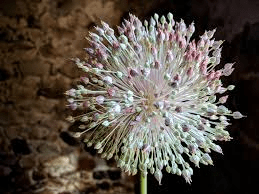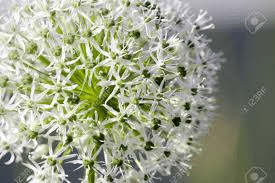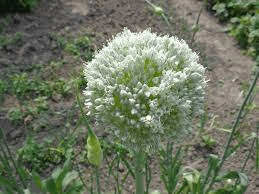The garlic inflorescence is a key aspect of its botanical structure, playing a crucial role in its reproduction and life cycle. Understanding the garlic inflorescence involves exploring its structure, development, and significance in both natural and agricultural contexts.
Garlic is a bulbous plant in the Allium genus, which also includes onions, leeks, and shallots. The inflorescence of garlic, specifically, is an umbel, a type of flower cluster. This umbel is typically found at the end of a long, leafless stalk called a scape, which emerges from the center of the garlic plant.
The scape is smooth and solid, growing up to a meter in height, and ends in a swelling where the umbel develops. This flowering structure consists of numerous small, individual flowers, which are often white or pinkish in color.
The umbel of garlic is initially enclosed in a protective sheath called a spathe. The spathe splits open as the umbel matures, allowing the flowers to emerge. Each flower within the umbel is attached to the main stalk by a pedicel, a small stem that supports the flower. Garlic flowers are generally hermaphroditic, containing both male (stamens) and female (pistil) reproductive organs.
The typical garlic flower has six tepals (a combination of petals and sepals that are undifferentiated), six stamens, and a three-part pistil.
Pollination in garlic can occur through various means, including wind and insect activity. However, many cultivated garlic varieties are sterile and do not produce viable seeds. Instead, these sterile flowers contribute to the production of bulbils, small, secondary bulbs that can develop in place of seeds within the umbel.
These bulbils serve as an alternative reproductive mechanism, allowing for vegetative propagation. This method of reproduction is particularly advantageous for maintaining the genetic uniformity of cultivated garlic, ensuring that desirable traits are preserved across generations.
The development of the inflorescence in garlic begins with the transition from vegetative growth to reproductive growth. This change is often triggered by environmental factors such as temperature and day length. As the garlic plant shifts to reproductive growth, energy is diverted from bulb formation to the development of the scape and umbel.
The timing of this transition is critical for farmers, as the presence of a scape can influence the size and quality of the garlic bulbs. Many farmers choose to remove the scape, a process known as “topping” or “cutting,” to encourage the plant to focus its energy on bulb development rather than flower and bulbil production.
Garlic inflorescence has both economic and ecological importance. From an agricultural perspective, understanding the development and management of the inflorescence can optimize garlic yields and quality. Ecologically, the flowers of garlic can provide a source of nectar for pollinators, although this role is limited in sterile cultivars.
In conclusion, the inflorescence of garlic is a fascinating and complex structure that plays a pivotal role in the plant’s reproduction. Its umbel, consisting of numerous small flowers or bulbils, emerges from a sturdy scape and is critical for both the plant’s natural propagation and agricultural cultivation.
While many cultivated varieties rely on vegetative propagation through bulbils, the inflorescence remains a key feature that underscores the botanical and economic significance of garlic. Understanding and managing garlic inflorescence can greatly benefit both natural ecosystems and agricultural practices, ensuring the continued success and utility of this versatile plant.
The Economic Importance and Uses of Garlic Inflorescence

Garlic inflorescence, the flowering part of the garlic plant, holds significant economic importance and diverse uses across various sectors. Here are 18 key economic aspects and applications of garlic inflorescence:
1. Seed Production: Garlic inflorescence is essential for producing seeds, especially in non-sterile varieties. These seeds are crucial for breeding programs and the development of new garlic cultivars.
2. Bulbil Production: Many garlic inflorescences produce bulbils, small bulb-like structures used for vegetative propagation. This method ensures genetic uniformity and maintains desirable traits.
3. Culinary Uses: The scapes of garlic, which bear the inflorescence, are edible and used in various culinary dishes. They add a mild garlic flavor to soups, stir-fries, and pesto.
4. Nutritional Supplements: Garlic inflorescence, like the bulbs, contains beneficial compounds such as allicin. Extracts from inflorescence are used in dietary supplements promoting heart health and boosting the immune system.
5. Natural Pesticides: Compounds in garlic inflorescence have insecticidal properties. Extracts are used as natural pesticides in organic farming to control pests and diseases.
6. Medicinal Uses: The inflorescence of garlic is rich in bioactive compounds. It is used in traditional and modern medicine for its antimicrobial, anti-inflammatory, and antioxidant properties.
7. Aromatherapy: Essential oils derived from garlic inflorescence are used in aromatherapy for their potential health benefits, including respiratory relief and stress reduction.
8. Livestock Feed: Garlic inflorescence can be used as a feed additive for livestock. It improves gut health and acts as a natural antibiotic, reducing the need for synthetic drugs.
9. Cosmetic Industry: Extracts from garlic inflorescence are incorporated into skincare products for their antibacterial and anti-aging properties.
10. Pest Repellents: Garlic inflorescence is used to create natural repellents for mosquitoes and other insects, providing an eco-friendly alternative to chemical repellents.
11. Soil Improvement: Residues from garlic inflorescence can be composted and used to enrich soil, improving its structure and fertility.
12. Biodegradable Packaging: Research is exploring the use of garlic inflorescence fibers in creating biodegradable packaging materials, contributing to sustainable packaging solutions.
13. Flavoring Agents: Garlic inflorescence extracts are used as natural flavoring agents in the food industry, enhancing the taste of various products.
14. Dye Production: The pigments in garlic inflorescence can be used to produce natural dyes for textiles, offering an eco-friendly alternative to synthetic dyes.
15. Biofuel Production: The biomass from garlic inflorescence can be processed to produce biofuels, contributing to renewable energy sources.
16. Animal Health Products: Extracts from garlic inflorescence are used in veterinary medicine to treat infections and improve animal health.
17. Waste Utilization: Utilizing garlic inflorescence reduces agricultural waste, promoting a circular economy by converting by-products into valuable resources.
18. Research and Development: Garlic inflorescence is a subject of scientific research aimed at discovering new applications and enhancing its economic value.
Read Also Scrapie in Sheep and Goats: Description, Damages Caused, Control and Preventive Measures
The Products and By-products That Can Be Derived From Garlic Inflorescence

Garlic inflorescence can be processed into various products and by-products, each with its own set of applications. Here are 17 examples:
1. Garlic Scape Pesto: Made from garlic scapes, this pesto is a popular culinary product used as a sauce or spread.
2. Garlic Scape Powder: Dried and ground scapes can be used as a seasoning in cooking.
3. Garlic Scape Pickles: Pickling garlic scapes preserves them and creates a tangy, crunchy condiment.
4. Essential Oils: Extracted through steam distillation, garlic inflorescence essential oils are used in aromatherapy and health products.
5. Dietary Supplements: Capsules and tablets containing extracts from garlic inflorescence are marketed for their health benefits.
6. Natural Pesticides: Extracts from garlic inflorescence are formulated into sprays for organic pest control.
7. Animal Feed Additives: Processed garlic inflorescence is added to animal feed to improve health and growth.
8. Skincare Products: Creams and lotions containing garlic inflorescence extracts are used for their antibacterial properties.
9. Mosquito Repellent: Sprays and lotions made from garlic inflorescence repel mosquitoes and other insects.
10. Compost: Residual plant matter from garlic inflorescence can be composted to enrich garden soil.
11. Biodegradable Plastics: Research is ongoing into using garlic inflorescence fibers to create biodegradable plastic alternatives.
12. Natural Dyes: Pigments extracted from garlic inflorescence can dye fabrics in eco-friendly ways.
13. Biofuels: Biomass from garlic inflorescence is converted into biofuels, offering renewable energy solutions.
14. Veterinary Medicines: Garlic inflorescence extracts are formulated into medicines for treating livestock diseases.
15. Flavoring Extracts: Concentrated extracts are used to enhance the flavor of food products.
16. Soil Amendments: Garlic inflorescence residues are processed into soil amendments to improve crop yields.
17. Research Tools: Components of garlic inflorescence are used in scientific studies to explore new uses and benefits.
Read Also : Norwegian Forest Cat Breed Description and Complete Care Guide
Frequently Asked Questions (FAQ’s) About Garlic Inflorescence

1. What is garlic inflorescence?
Garlic inflorescence is the flowering part of the garlic plant, which includes the scape and the umbel containing small flowers or bulbils.
2. Can garlic inflorescence be eaten?
Yes, the scapes of garlic inflorescence are edible and used in various culinary dishes.
3. How is garlic inflorescence used in medicine?
Garlic inflorescence is used for its antimicrobial, anti-inflammatory, and antioxidant properties in both traditional and modern medicine.
4. What are bulbils in garlic inflorescence?
Bulbils are small, secondary bulbs that form in the place of seeds within the garlic inflorescence, used for vegetative propagation.
5. How does garlic inflorescence benefit agriculture?
It provides natural pesticides, improves soil fertility through composting, and offers a renewable source of biomass for biofuels.
6. Can garlic inflorescence be used in skincare products?
Yes, extracts from garlic inflorescence are used in skincare products for their antibacterial and anti-aging properties.
7. What are the environmental benefits of using garlic inflorescence?
It helps reduce agricultural waste, provides natural pest control, and contributes to sustainable practices like biodegradable packaging.
8. Are there any industrial uses of garlic inflorescence?
Yes, garlic inflorescence is used in the production of natural dyes, biodegradable plastics, and biofuels.
9. How is garlic inflorescence processed into essential oils?
Essential oils are extracted from garlic inflorescence through steam distillation, capturing the aromatic compounds.
10. What role does garlic inflorescence play in garlic cultivation?
It is crucial for seed and bulbil production, influencing the propagation and genetic consistency of garlic crops.
